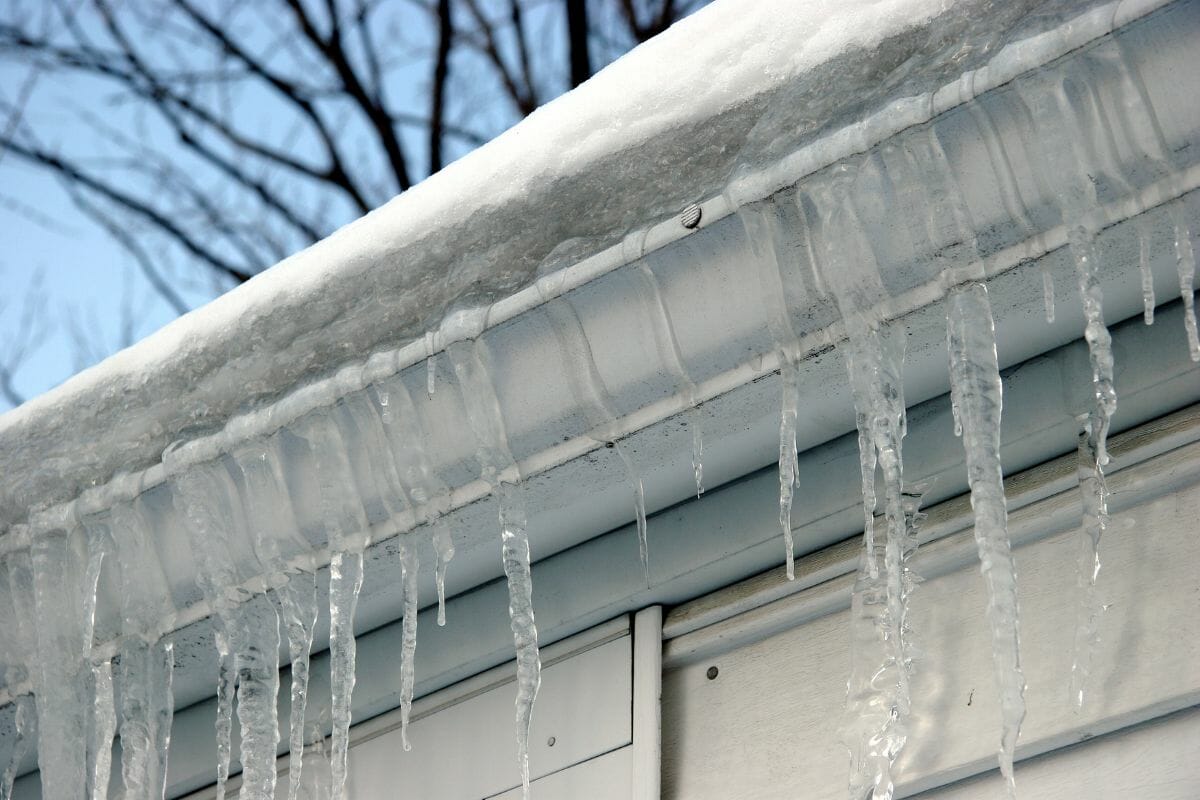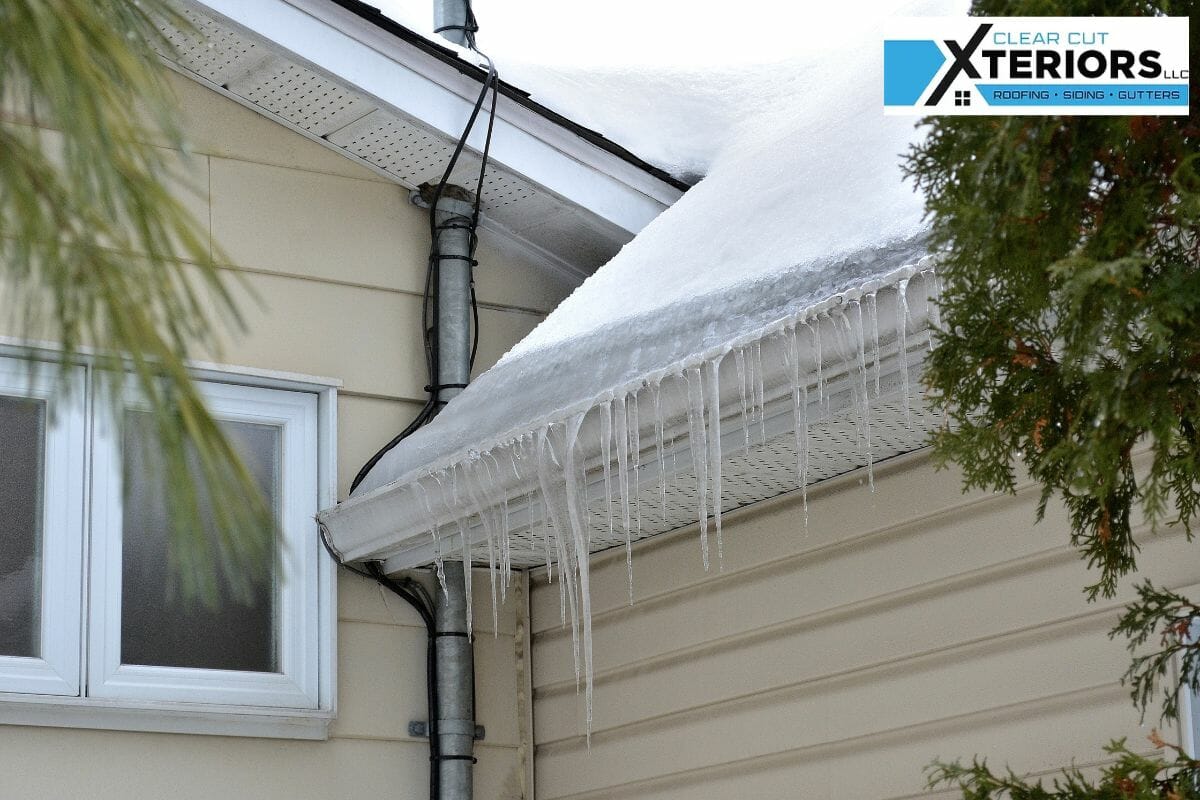The winter season is here, which means it’s time to pay extra attention to the way the weather may cause problems for your roof. One such roofing problem that many homeowners face this season is the formation of ice dams.
Are you tired of dealing with the hassle and damage caused by ice dams on your roof? If so, you’re not alone. Ice dams can be a major headache, causing damage to your roof, gutters, and even the interior of your home. But fear not! At Clear Cut Xteriors LLC, we have years of experience in improving the roofs and attics of many homeowners in Minnesota. Our team has dealt with the problem of ice dams in the past and can help you too.
In this blog, we’ll dive into everything you need to know about ice dams, including their cause, ice dam prevention, and some tips to help remove these ice barriers. By the end of this post, you’ll be armed with the knowledge you need to keep your roof ice-free all winter long.
What Is An Ice Dam?
If you are a proactive homeowner concerned about the upcoming winter season and its effect on your roof, then the first question you may be concerned about is: What is an ice dam on the roof?
An ice dam is a ridge of ice that forms on the edge of a roof, usually along the gutter line. It occurs during winter when there is snow on the roof, and the internal temperature of your attic fluctuates across different areas. While the peak may be warm due to the way heat rises, the eaves of your roof are below freezing. As the snow on the peak of your roof begins to melt due to the warmth of the attic space, the water flows down the roof toward the colder edges. When it reaches the roof’s edge, which has a lower temperature, the water freezes again. Continuous cycles of this form an ice dam.
Just like a man-made dam constructed to restrict the flow of water, an ice dam restricts the melted ice and snow from reaching your gutter systems.

What Temperature Does Snow Start Melting?
When discussing ice dam formation on a roof, 32 degrees Fahrenheit should be considered the critical number. When the roof’s surface temperature heats up to more than 32 degrees in winter, it is enough for the snow to melt. The outside temperature and the temperature at the roof’s eaves are normally lower than 32 degrees, which will cause the snow to refreeze once it reaches this part.
What Happens When An Ice Dam Forms On Your Roof?
When the snow melts and refreezes on the edge of your roof forming an ice dam, it stops the natural flow of water to the gutter system. As winter goes on snow will keep accumulating on the roofing system, and continue to melt off the peak, adding to this ice dam and making it bigger. With time, water that’s melted will have nowhere else to go and will pool and begin to seep under your roof’s shingles. This water will eventually find its way into your home if left unnoticed.
It’s essential to address ice dams as soon as you notice them to prevent further damage. The longer you ignore the ice damming on your roof, the bigger the dam will get and the more damage it will cause to your property.
Damaging Effects Of Ice Dams On Your Home
Ice dams can cause several problems, including the following:
- Damage to the home’s roof
- Damage to the gutters, and interior
- They can also create an avenue for water to leak into the house, leading to water damage and the potential for mold growth.
How To Prevent Ice Dams On The Roof
Prevention is better than repair. It is better to take preventive measures for your roof rather than spend thousands on roof repair or complete roof replacement in the worst-case scenario.
In the following section, we will share some tips that you can use to prevent ice dams from occurring, and keep your property safe this winter.
Attic Insulation Is The Key
Attic insulation is one of the significant steps that you need to take for ice dam prevention since the warm air in your attic is responsible for the snow melting. During winter, when your HVAC systems make your home warm, this warm air rises to the attic, which is not conditioned. Proper insulation can help keep the heat inside your home and prevent the formation of ice dams.
To properly insulate your attic, you should first determine the type of insulation already in your attic, and whether it is sufficient. If your attic is not sufficiently insulated, consider adding more insulation to reach the recommended level for your climate, and home type.
You can use several types of attic insulation, including fiberglass batts, cellulose, and spray foam. Each type has its benefits and drawbacks, so it is important to consider which type is best for your home.
Ventilate The Attic
Not only should you use insulation, but ventilating the attic can also help in preventing ice dams. This can be done by ensuring proper airflow in the attic space, which you can achieve by installing vents on the eaves and along the roofline. These vents allow for consistent temperatures to be kept across the entire home. Ridge vents are especially helpful in keeping the attic space cool by allowing hot air to escape through the vent.
Seal Air Leaks
Air leaks in your roof or exterior walls can allow warm air to escape from your home, which can cause ice dams to form. To help prevent ice dams, it is essential to seal any gaps or cracks that may allow warm air to escape.
The routes for these leaks can be found in the following forms:
- Gaps around wires
- Gaps in the drywall
- Penetration along the ceiling area
These openings may seem small but can affect the attic temperature significantly. Addressing these gaps as soon as you see them can go a long way in preventing ice dams from forming on your roof.
How To Stop Air Leaks
It will require some effort on your part, but you can easily seal these air leaks. Go to the attic and use caulk, foam, or another sealant to plug the unnecessary openings. You can also use spray foam to cover holes and seal around pipes.
Clean The Gutters
You need to keep your gutters clean so that melting snow and rainwater can easily pass through the channel and down through the downspouts. During the winter season, there is a higher chance of your gutters getting clogged due to leaves and debris. A clogged gutter will force the melted snow to stay on the roof and freeze near the edges.
Check your gutters and downspouts regularly to make sure they are clear and working correctly.
How To Get Rid Of The Ice Dams
The winter season can be pretty harsh in Minnesota. So more often than not, your roof may get covered with ice. Ice dams can form if you do not have appropriate insulation in your attic. Here are some of the following things you can do to remove ice dams.
Remove Snow From The Roof Regularly
Use a roof rake or a shovel to remove as much snow as possible from the roof, starting at the eaves and working your way up. Be cautious when working on the roof and follow proper safety guidelines.
Repair Any Leaks Or Damage
If you have leaks or damage to your roof, it’s important to repair them as soon as possible. This can help to prevent water from seeping into your home and causing further damage.
Hire A Professional
If you cannot remove the ice dam or are unsure how to do so safely, it may be best to hire a professional. A professional will have the necessary equipment and experience to safely remove the ice dam and repair any damage to your roof. For this, Clear Cut Xteriors LLC offers the best services.
Top Ice Dam Removal Products You Can Use
Various ice melt products are available to help melt the ice dam. These products are typically applied to the surface of the ice dam and work by lowering the freezing point of the water.
Use An Ice Melt: You can use an ice melt specifically designed for roofs to prevent ice dams from forming, which can be found at your local hardware store. All you have to do is place the tablet on top of the ice you want to be melted, and allow it to do its job. However, ice melts only work up to a certain freezing point.
Use Heat Cables: Heat cables can be installed on your roof to help prevent the formation of ice dams. These cables are placed along the edge of your roof and use electricity to heat up and melt the snow and ice. The heat cables help increase the roof’s temperature from the outside but note that they can get damaged in harsh weather conditions.
Need Assistance With Ice Dam Removal? We Can Help!
As we have seen from the above blog, an ice dam is quite a severe problem, and we hope you’ll be more alert to moisture in your attic, or ice building up on your roof. If you are looking for a professional roofer with years of experience, contact the team of Clear Cut Xteriors LLC. We are the best roofing company serving Minneapolis and the surrounding areas of Minnesota.
We provide solutions to various roof problems in Minneapolis, Minnesota, with our quality roof repair services. Whether it’s ice dam formation, missing shingles, or leaks, we can help. Contact us today at, (651) 340-3410 to discuss your roof, and we will be happy to help you!



